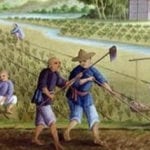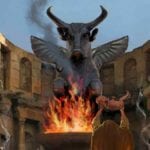 Misconceptions
Misconceptions  Misconceptions
Misconceptions  History
History 10 Amazing Roman Epitaphs
 Weird Stuff
Weird Stuff 10 Niche Subcultures That Are More Popular Than You Might Think
 Mysteries
Mysteries 10 Tragic Disappearances and Deaths in Joshua Tree National Park
 History
History 10 Ways Childhood Really Sucked in the Old West
 Music
Music 10 Name Origins of Famous Bands from the 1990s
 Religion
Religion 10 Biggest Turnarounds by the Catholic Church
 Weird Stuff
Weird Stuff 10 Unbelievable Times Laws Had Unintended Consequences
 Humans
Humans Ten Historic Women Who Deserve Way More Credit Than They Got
 Movies and TV
Movies and TV 10 Films That Spawned Major Lawsuits
 Misconceptions
Misconceptions 10 Phony Myths and Urban Legends That Just Won’t Die
 History
History 10 Amazing Roman Epitaphs
 Weird Stuff
Weird Stuff 10 Niche Subcultures That Are More Popular Than You Might Think
Who's Behind Listverse?

Jamie Frater
Head Editor
Jamie founded Listverse due to an insatiable desire to share fascinating, obscure, and bizarre facts. He has been a guest speaker on numerous national radio and television stations and is a five time published author.
More About Us Mysteries
Mysteries 10 Tragic Disappearances and Deaths in Joshua Tree National Park
 History
History 10 Ways Childhood Really Sucked in the Old West
 Music
Music 10 Name Origins of Famous Bands from the 1990s
 Religion
Religion 10 Biggest Turnarounds by the Catholic Church
 Weird Stuff
Weird Stuff 10 Unbelievable Times Laws Had Unintended Consequences
 Humans
Humans Ten Historic Women Who Deserve Way More Credit Than They Got
 Movies and TV
Movies and TV 10 Films That Spawned Major Lawsuits
10 Brutal Facts About Growing Up In The Aztec Empire
Parents just don’t raise kids like they used to. Back in the good ol’ days, people raised their kids to be tough and didn’t balk if that meant being strict with them. If a kid had to be held over a fire, forced to carry logs until he collapsed, or sent to starve in a temple, nobody looked twice.
Of course, in those days, we had real leaders—like the king of kings, Moctezuma II, who struck fear in the hearts of his enemies for the glory of Huitzilopochtli, bird-god of war and human sacrifice.
We’ll probably never get back to North America’s real traditional values. But here’s a glimpse into what life was like when men were men, women were women, and flayed gods demanded blood.
10 Newborn Babies Were Told That Life Is Pain

The Aztecs didn’t believe in lying to children—no matter how young they were. When they heard a newborn baby crying, they didn’t coo to it or try to convince it that everything was going to be fine. As far as they were concerned, that newborn baby had the right reaction to being alive—and they made sure those were the first words the baby heard.
As soon as a baby was born, an Aztec midwife would take it in her arms, cut the umbilical cord, give a prayer of thanks, and then lay down some hard truths. She’d look that newborn baby right in the eyes and, as a religious necessity, say, “Life is all affliction.”[1] Then, to really drive the point home, she’d promise the baby that he would die a horrible and violent death either in war or as a human sacrifice.
It didn’t matter if you were rich or poor—everyone got the same treatment. The children of nobility would even get regular talkings-to where they were reminded that, even if they found great success in life, it would only bring them more sadness.
9 Parents Thought Children Only Grew If You Stretched Them

Aztec parents didn’t really understand that kids grew on their own. They knew that babies got bigger over time, but they didn’t fully comprehend that this was just the way a body worked. They thought the only way to make sure that a child grew up big and tall was to stretch him out. So that’s what they did.
Parents would hold regular ceremonies called “The Stretching of People for Them to Grow.”[2] First, they’d grab their baby by the neck and dangle him in the air, thinking that gravity would make the kid taller. Then they’d pull on every part of the baby’s body—arms, legs, nose, and ears—to make sure that every part grew out evenly.
There were all kinds of rules that parents had to follow to make sure their kids didn’t stay more or less the same height. If there was an earthquake, parents had to grab their children by the necks. At mealtime, younger brothers had to let their elder brothers drink first. Every rule had to be followed or else the gods would curse your children to a lifetime of being short.
8 Misbehaving Children Were Dangled Over Fires
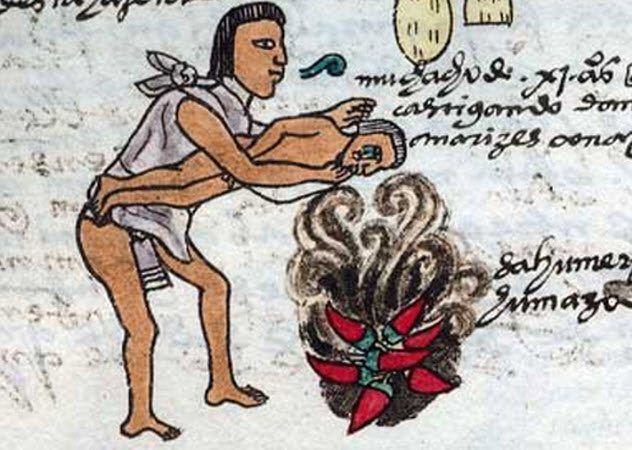
Aztec kids weren’t lazy. Their parents made sure of that. By the time a child was eight years old, the parents figured he was ready to take some responsibility in his life. He was expected to get up early, do what he was told, and never dawdle. And if he didn’t, his parents saw to it that he learned his lesson.
If a young Aztec child misbehaved, the parents would stab their child with the spines from a maguey cactus. If it was a small offense, the kid would get a light prick in the wrist. But if he was really bad, it could get serious. Parents would strip their kids naked, bind their arms and wrists, and cover them with maguey spines.[3]
Once a child turned 11, the punishments became really severe. At that age, a father could hold his child over burning chili peppers in a fireplace and make him inhale the acrid smoke. They had to keep that one short, though. If the parents kept their kids there too long, it would kill them.
7 Poor Children Were Forced To Lug Wood Around
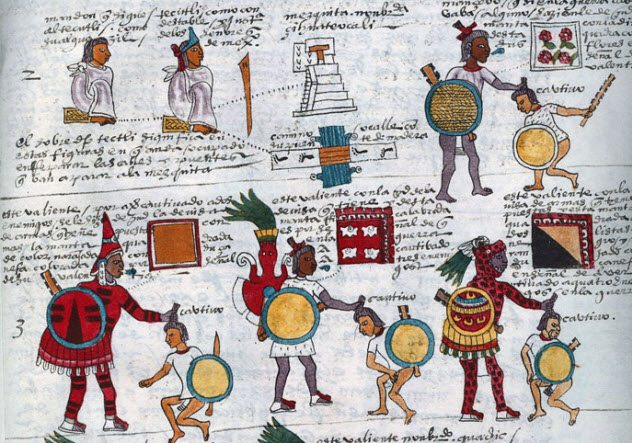
When children turned 15, they were sent off to school. In the Aztec Empire, education was compulsory for all children, no matter who they were. But Aztec kids had to do a lot more than just learn fractions.
A poor child would be sent to the telpochcalli, where he would learn a trade and be tested in the art of war.[4] Their teachers would be watching these kids to see if they were tough enough to become soldiers—and the teachers put the kids through hell trying to find out.
Boys in the telpochcalli would have to go into the forest and gather firewood—partly because they needed it and partly just to see how tough they were. Every time a boy went out, he’d be required to carry one more log than he had the previous time. Each day, they’d pile more and more wood on him until he literally collapsed.
If the boy broke down after the first few trips, he’d probably end up being nothing more than a peasant. But if a boy could carry more than his own weight, his teachers would take notice. This was a future warrior. From then on, instead of wood, he would carry weapons to the battlefields.
6 Noble Children Were Starved And Tortured
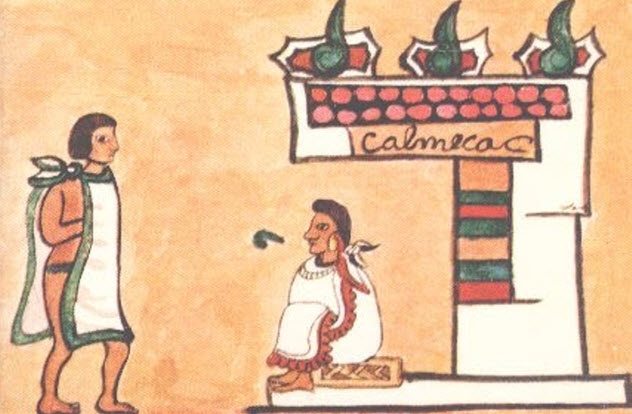
Noble children—and a few poor children nominated by the priests—would be sent to the calmecac, a school run by the Aztec head priest. The kids would be trained as novice priests and prepared to become the most important men in the empire. They would become holy men, military leaders, and government officials. All of this sounds great on paper, but in practice, it was a living hell.
Students in the calmecac were expected to learn sacrifice and self-denial. They would rise before dawn and sweep the temple. Then, when the work was done, they would start fasting. They were taught to be “fond of empty-guttedness,” so they were actively starved at every opportunity.
They would paint their entire bodies black, and that paint was almost the only thing on their bodies. They were barely allowed to wear any clothes because the priests thought that the kids would learn to be penitent if they were freezing to death. If anyone complained, the priest would beat him.[5]
Spanish missionaries called the calmecac “a house of weeping, tears, and sorrows,” and the Aztecs didn’t totally disagree. Before a child was sent there, his parents would tell him to forget what it was like to live in the comfort and love of home. “It is ended,” the child was told. “Thou goest knowing it.”
5 Boys Who Hadn’t Captured Anyone Were Publicly Shamed
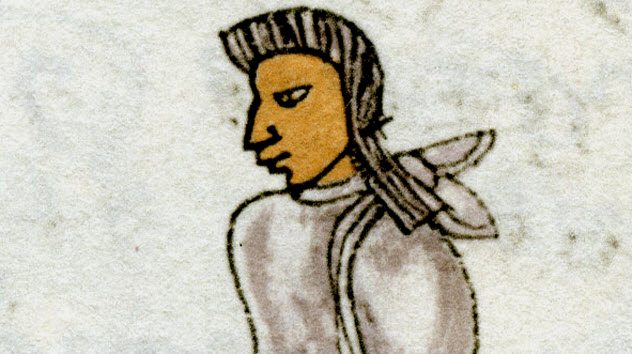
A boy couldn’t become a man until he’d captured an enemy in battle. Until then, he was a disgraceful little boy and the Aztecs made sure everyone knew it.
When a child turned 10 years old, his parents would shave all the hair on his head except for one tuft. From then on, that child was forbidden from cutting off the tuft until the day he defeated an enemy in battle and returned the captive to the empire, often to be used a human sacrifice. Until then, the child had a growing tuft of hair to show the world his shame.
The strong boys who could carry enough lumber to get sent to the battlefield would try to get involved as soon as they could. It was fairly common for a young boy who was only supposed to be carrying supplies to rush into the heat of battle and try to participate. More often than not, those boys ended up dead. But if they survived, they’d come home as heroes.
Boys who didn’t have the level of courage that straddles the line of insanity were stuck with their long tufts of hair. In that case, just going outside was torture. Girls would crowd around them and taunt them. “It is a stinking tuft of hair!” the girls would yell. “Art thou not just a woman like me?”[6]
4 Lazy Children Were Burned With Firebrands

Being punished by your parents was bad enough. But once a child started going to school, it got really harsh. Boys in the telpochcalli who didn’t do their best weren’t just held over a fire. They were put right into it.
If a young boy got caught doing nothing or being careless with his work, he would get the firebrand. His teacher would grab him by that shameful tuft of hair and drag him into a public place. It was brutal and humiliating—but even more so in their culture. Normally, being grabbed by the tuft meant that you’d been captured in war and were going to be sacrificed to the gods.
These kids weren’t killed, but they definitely didn’t get off easy. Their masters would cut off every hair on their heads, leaving only the tuft of shame and then would singe the boys’ heads with a firebrand. The Aztecs called it “being old-ladied.” Nobody knows exactly how it got that name, but it makes one thing clear: If an Aztec child was old-ladied, nobody felt sorry for him.[7]
3 Mandatory Late-Night Dance Parties

Whether rich or poor, every Aztec child had to go to the cuicacalli. It was basically an all-night dance party—and in Aztec culture, getting down was mandatory.
This was the only place that Aztec boys and girls were allowed to be together. In school, they were separated. But when night fell, they were sent out to temples to party. There, the boys and girls would learn to sing sacred songs, dance ritual dances, and hear the stories of the gods and men.[8]
For the adults, this was a way to teach the new generation their culture. The kids learned about religion and philosophy through the lyrics of the songs, and they were introduced to the rituals they would have to follow for the rest of their lives.
To the kids, this was mostly just a way to meet the opposite sex. Boys would try to show off their burgeoning muscles to impress the girls, while girls would whisper little flirtations to try to impress the boys.
It was their only real chance to get together, and they took it. When the party ended and everyone was sent home, it wasn’t uncommon for some young couples to sneak off into the night and break a few rules together.
2 Boys Who Had Premarital Sex Were Publicly Beaten
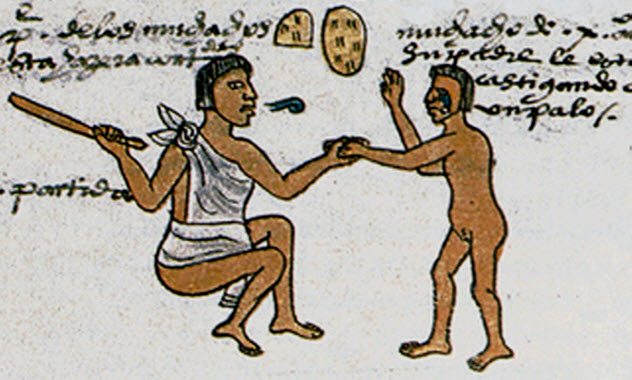
Sneaking off with a sweetheart wasn’t always a great idea. Abstinence was a big deal for the Aztecs. Fathers would sit down with their sons and encourage them to stay pure until their wedding nights, promising that they’d have more vigor if they abstained. And if a boy didn’t take his father’s advice, he’d find out just how seriously his people took saving themselves for marriage.
If a boy was caught with a prostitute or in the bed of a woman, he would be tortured for it. Sometimes, that meant having pine needles stuck in every inch of his body. But sometimes, it was a lot worse than that.
In one case, a man who was caught sleeping with a young girl was stripped of all possessions, had his hair cut, and was dragged into the courtyard. There, they beat him with a pine stick and burned his body with the firebrand until—to quote the original description—“his body was smoking.”
“With this, they cast him forth,” an eyewitness wrote. “He just slowly crept away; he was going from one side to the other; he just went confused. [ . . . ] He withdrew forever; nevermore was he to sing and dance with the others.”[9]
1 Noble Children Were Ordered To Cut Themselves

The noble children didn’t get off any easier. The children in the calmecac were beaten just like the poor kids. But for them, it didn’t stop there. They were required to hurt themselves, too.
Noble children were required to perform “autosacrifice” regularly. If they’d done something wrong, for example, they would be expected to wander out in the middle of the forest and stab themselves with maguey spines.
Even if a child never did anything wrong, though, he still had to hurt himself. A child could never move past the rank of “novice priest” until he started walking around with his own blood smeared on his ear.
Every night at midnight, the boys of the calmecac would be awakened and forced to go to the midnight prayer. There, they either stabbed themselves in the shinbones with maguey spines or, if it was a special occasion, cut open their arms and rammed reeds into the wounds.
The bloody reeds and maguey spines would be sacrificed to the god of the Sun. But not all sacrifices were equal. Whoever could spill the most blood was considered the greatest and most penitent. And that was a great honor. If he was really penitent, he might even become head priest one day—and then that lucky boy would get to do this every day for the rest of his life.[10]
Read more fascinating facts about the Aztecs on 10 Fascinating Facts About the Aztecs and 10 Horrors Of Aztec Ritual Human Sacrifice.


